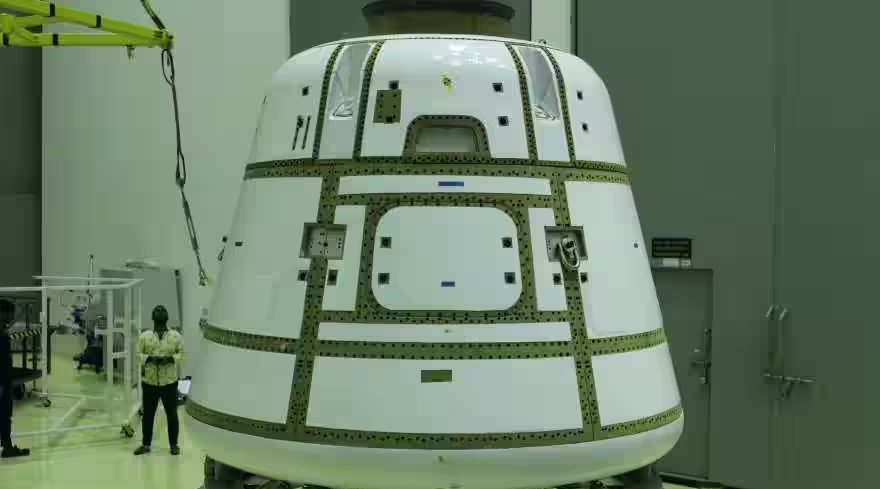
As part of its Gaganyaan mission, the Indian Space Research Organization is getting ready for an unmanned test flight. Isro will launch an empty crew module on October 21 to test the effectiveness of the emergency escape system.
Aspects like parachutes for spaceship stabilization during reentry will also be tested. The Navy will locate the crew module in the Bay of Bengal. To reach India’s objective of launching astronauts into low-Earth orbit by 2024, this test is a critical milestone.
The test, which will take place at the Satish Dhawan Space Centre in Sriharikota, will involve the ‘crew module,’ or the area of the vehicle where the Indian astronauts would be housed.
According to Jitendra Singh, Minister of State for Space, Science, and Technology, the Indian Space Research Organization (ISRO) will launch the first of numerous test flights on October 21 in advance of the Gaganyaan mission, which will be India’s first manned space voyage.
The module will be sent into orbit, retrieved upon landing in the Bay of Bengal, and brought back to Earth. Mr. Singh claims that the Navy forces have already started mock recovery operations.
The crew module will be featured in addition to “Crew Escape” technology. When the spacecraft ascends into orbit, this escape device is designed to detach in the event of a problem and bring the crew safely back to the sea, where they will be picked up by Navy personnel.
The module will be identical to the one that was launched into orbit for the first test, known as Test Vehicle Abort Mission (TV-D1), with the exception that it will be “unpressurized.”

Also read: Less than 1% IITians in ISRO, they don’t want to join: ISRO Chief Somanath
Procedures for Crew Escape
The TV-D1 test vehicle, a single-stage liquid-fueled rocket, was developed for this abort mission. The payloads, which replicate the abort scenario during the ascent trajectory corresponding to the anticipated Mach number of 1.2 for the Gaganyaan mission (one mach is equal to 330 meters per second, or the speed of sound), are the crew module and crew escape devices.
The CES with CM will be separated from the Test Vehicle at a height of approximately 17 kilometers. Then, an automatic abort sequence will be carried out, beginning with the separation of the CES and the deployment of a series of parachutes, and culminating with the safe touchdown of the CM in the sea, approximately 10 kilometers off the coast of Sriharikota, according to a statement from ISRO
If this test is successful, according to Mr. Singh, it will open the door for the initial unmanned “Gaganyaan” mission and ultimately a manned trip to low Earth orbit. Before the last manned “Gaganyaan” mission, the female robot astronaut “Vyommitra” will make a test flight in the coming year.
It is anticipated that the Gaganyaan mission will be carried out in the second half of next year.
The Indian Space Research Organisation places utmost priority on Gaganyaan, India’s ambitious human spaceflight goal, for a number of compelling reasons. First of all, it represents India’s technological supremacy in space, demonstrating the country’s capacity to carry out challenging missions.
India’s standing in the international space community is raised by ISRO’s foray into human spaceflight, which showcases its expertise in engineering, materials science, and astronaut safety measures.
Second, Gaganyaan encourages scientific investigation and invention. The mission contains challenging studies, including the study of human physiology in microgravity and the testing of brand-new space home technologies. These activities produce priceless information that advances not only Earthly environmental study but also sectors like health and materials science.
Likewise, Gaganyaan inspires and educates. It ignites curiosity among the youth, encouraging them to pursue careers in wisdom, technology, engineering, and mathematics( STEM).
This charge serves as a lamp of aspiration, motivating generations to come, fostering a culture of scientific inquiry and discovery.
Paramount significance for ISRO and the nation as a whole.
Gaganyaan enhances transnational collaboration. By venturing into mortal spaceflight, India becomes a significant mate in global space trials, uniting with other space agencies, participating knowledge, and contributing to the collaborative advancement of humanity’s disquisition of the macrocosm.
In substance, Gaganyaan symbolizes India’s technological prowess, scientific advancement, educational stimulant, and global collaboration, making it a charge of consummate significance for Indian Space Research Organization and the nation as a whole.






























































































































































































































































































































































































































































































































































































































































































































































































